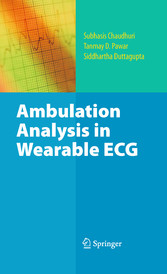Suchen und Finden
Ambulation Analysis in Wearable ECG
2
Preface
6
Acknowledgments
9
Contents
10
1 Introduction
13
1.1 Basics of Electrocardiogram (ECG)
13
1.2 Artifacts in ECG
17
1.2.1 EMG Noise
17
1.2.2 Baseline Wandering
17
1.2.3 Powerline Interference
18
1.2.4 Motion Artifacts
18
1.3 Ambulatory Monitoring
18
1.4 Challenges in Ambulatory ECG Processing
20
1.5 Mathematical Model of Ambulatory ECG Signal
21
1.6 Tour of the Book
22
2 Review of ECG Analysis
26
2.1 QRS Detection Methods
27
2.2 Delineation of Wave Boundaries
29
2.3 Beat Alignment
31
2.4 Noise Reduction in ECG
32
2.5 Detection of Body Posture Changes
34
2.6 Overview of Wearable ECG Recorders
35
2.7 Analysis of Ambulation in ECG
36
3 Hardware Development of Wearable ECGDevices*
38
3.1 Introduction
38
3.2 Basics of Personal ECG Instruments
39
3.2.1 System Modules and Operation
39
3.2.2 System Requirements
40
3.3 Electrodes
40
3.4 Signal Conditioning
41
3.4.1 Implementation Using General-Purpose ICs
42
3.4.2 ASIC (Application-Speci c Integrated Circuit) Design forSignal Conditioning
44
3.5 Analog to Digital Converter
50
3.6 Digital Modules
53
3.6.1 Microcontroller
53
3.6.2 Data Storage
53
3.6.3 Data Retrieval
54
3.7 Discussion
54
4 Calibration of Locket
55
4.1 Calibration Requirements
56
4.2 Experimental Set-up
57
4.3 Calibration Technique
58
4.4 Results and Discussion
59
5 Data Acquisition
63
5.1 Introduction
63
5.2 Commonplace Body Movement Activities
64
5.3 Activity Transition
65
5.4 Motion Sensing
67
5.4.1 Data Collection using Accelerometer
67
5.4.2 Processing of Accelerometer Data
69
5.5 Variation of Activity Levels
70
5.6 Protocols for Treadmill Tests
70
6 Detection of Activity Transition
72
6.1 Introduction
73
6.2 Transition Detection
75
6.3 Experimental Results
79
6.4 Discussion
86
7 Activity Recognition
87
7.1 Introduction
88
7.2 Nonparametric Classi cation
90
7.2.1 Preprocessing
92
7.2.2 Principal Component Analysis (PCA)
94
7.2.3 Supervised Learning of Body Movement
96
7.2.4 Activity Classi cation
98
7.2.5 Removal of Motion Artifacts
99
7.3 Parametric classi cation
99
7.3.1 Pre-processing
101
7.3.2 Feature Extraction
103
7.3.3 Hidden Markov Model (HMM) and Training
105
7.3.4 Activity Classi cation
107
7.4 Experimental Results
108
7.4.1 PCA-based Recognition
108
7.4.2 HMM-based Recognition
119
7.5 Discussion
128
8 Impact of Ambulation
130
8.1 Introduction
131
8.2 Derivation of Impact Signal
132
8.3 Synchronization of Impact and Motion Data
133
8.4 Experimentations
134
8.4.1 Experiments on the Treadmill
134
8.4.2 Experiments with Motion Sensors
137
8.5 Discussions
145
9 Conclusions
149
9.1 Conclusions
149
9.2 Scopes for Future Work
151
References
154
Index
163
Alle Preise verstehen sich inklusive der gesetzlichen MwSt.












